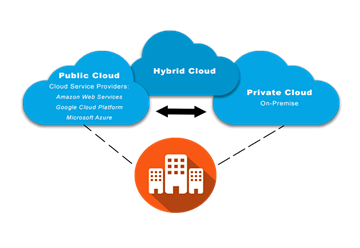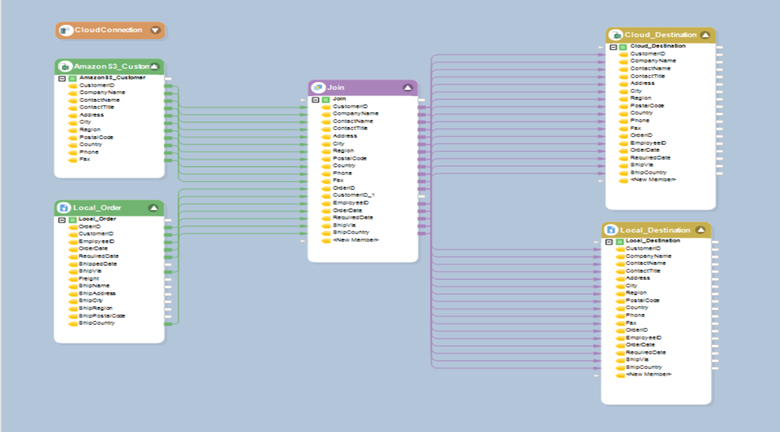
Hybrid Cloud Integration: Tips for Successful Implementation
Hybrid cloud integration has paved the way for businesses to enjoy the best of on-premise and cloud systems. By integrating on-premises data systems with cloud environments, companies can take advantage of the cloud without completely decommissioning their legacy systems.
The 2022 Global Hybrid Cloud Trends Report by Cisco shows that 82% of organizations have adopted the hybrid cloud, which isn’t surprising given the growing popularity of hybrid data architectures among modern IT professionals.
Do you want to reap the benefits of hybrid cloud? Well, unlocking the true value of this data infrastructure requires effective strategy and implementation plan. Here’s a guide to seamless hybrid cloud integration to help you get started:
Exploring Hybrid Cloud Integration

Image Source: Avi Networks
Why are Businesses increasingly opting for Hybrid Cloud Integration?
The rapid advancements in digitization and the consequent data explosion have forced businesses to look beyond traditional data infrastructures. As companies opt for off-premise solutions, cloud data migration is on the rise. Moving to the cloud offers greater flexibility and scalability, allowing businesses to solve data storage issues. Moreover, the enhanced security and backup features make cloud-based infrastructures hard to ignore.
However, it does not mean you must give up your existing on-premises system that work efficiently. Hybrid cloud integration is an excellent solution for connecting your workloads in the cloud and on-premises data centers under one management system.
Here are some key benefits of hybrid cloud integration:
-
Ownership of Data
If you deal with sensitive data, you can benefit from IT infrastructure modernization without forgoing your legacy systems. By storing sensitive information on-premises and less critical data on the cloud, you can tactfully house your data to meet compliance and security requirements.
-
Business Continuity
Public cloud companies have nearly perfected their security and uptimes, but they are still vulnerable to downtimes. With hybrid cloud infrastructure, you can avoid unplanned downtime and keep your systems running so that your company’s bottom line doesn’t take a hit.
-
Incremental Cloud Migration
Cloud data migration can be overwhelming. Hybrid cloud integration allows you to move incrementally toward the cloud. You can transfer some workloads to the cloud and then expand cloud capacity iteratively. This way, you can modernize your data Infrastructure with minimal risk of data loss.
-
Increased Scalability
Hybrid cloud integration optimizes IT performance and provides agility, allowing you to expand your workload on the cloud. You can process smaller, urgent datasets on local servers and complex datasets on the cloud. Essentially, you have unlimited scalability due to the availability of on-demand cloud resources.
-
Lower Total Cost of Ownership (TCO)
A combination of on-premises and cloud data systems helps you leverage elasticity and resource-usage optimization of modern solutions without heavily investing in new hardware and data infrastructure. The lower operating expenditure results in a lower TCO in the long-run, thereby improving business outcomes.
Implementing Hybrid Cloud Integration
When working with multiple environments, you need a robust hybrid cloud integration strategy that streamlines data movement across the enterprise. Here are some tips to keep in mind when adopting a hybrid cloud deployment model:
- Determine the criticality of your data to identify the workloads to be moved to the cloud. Ideally, you should keep critical data that requires additional security on-premises and move applications with a variable load to the cloud.
- Understand and assess potential data quality challenges in a hybrid cloud environment. Implement proper data validation rules and policies to ensure data accuracy and completeness.
- Evaluate the location of your data. Know where your critical data resides, its dependencies, and whether it contains any personally identifiable information (PII).
- Enforce data governance rules to ensure the discoverability, accessibility, and security of data in enterprise systems.
- Ensure that points of connection are resilient and can meet disaster recovery requirements.
- Assign role-based access to users to ensure compliance with data privacy laws.
Choosing the Right Hybrid Cloud Integration Tool
A hybrid cloud data integration tool can effortlessly connect multiple environments, giving you a bird’s eye view of your enterprise data. Here are the key factors you need to consider when choosing a hybrid cloud integration platform:
-
Supports multiple systems
Compatibility with different systems is perhaps the most critical factor determining your purchase decision. Pick a solution that supports a variety of on-premises and cloud systems. Ideally, it should natively support your existing enterprise systems.
-
Ease of use
Look for zero-code options with an intuitive user interface, so your business users and data architects can learn them quickly and manage data with minimal IT intervention. Code-free solutions are faster and easier to use.
-
Unified platform
Consider a tool that supports various data management tasks, including data extraction, migration, and integration, to avoid dealing with multiple vendors. A unified platform will help you create a consistent data architecture that scales with your business.
-
Automation and Orchestration
Opt for a solution that can automate and streamline manual, repetitive processes to help eliminate human errors and accelerate the data integration process. Automation will help you save time and costs as well as undertake big data initiatives.
-
Data Quality
Choose a tool with built-in data quality features, such as custom data validation rules, to ensure your data systems contain accurate and reliable data that provide trusted, near real-time insights for reporting and analytics.
Streamline Hybrid Cloud Integration with Astera Centerprise
Astera Centerprise is a code-free data integration tool with powerful ETL/ELT capabilities. Using the intuitive, drag-and-drop user interface, you can set up automated data pipelines within minutes to make analysis-ready data available for decision-makers.
Astera Centerprise allows you to integrate hybrid systems in a zero-code environment.

Integrating on-premises and cloud systems using Astera Centerprise
Using Astera Centerprise, you can:
- Extract data from disparate sources and load it into the destination of your choice using native connectors seamlessly.
- Connect to popular databases, data warehouses, and cloud providers, including Snowflake, Amazon RDS, Netezza, SQL Server, Amazon S3, Microsoft Blob Storage, and more.
- Alter and manipulate data using a library of built-in transformations for flat and hierarchical data processing, data merging, change data capture, and more.
- Define data quality rules and validate incoming data against them to maintain clean and consistent data across all environments.
- Leverage powerful automation capabilities that drastically accelerate data integration and reduce data latency.
Download the 14-day free trial to explore its features and learn how your enterprise can strategically simplify its operations using it.
 Astera AI Agent Builder Coming Soon
Astera AI Agent Builder Coming Soon

